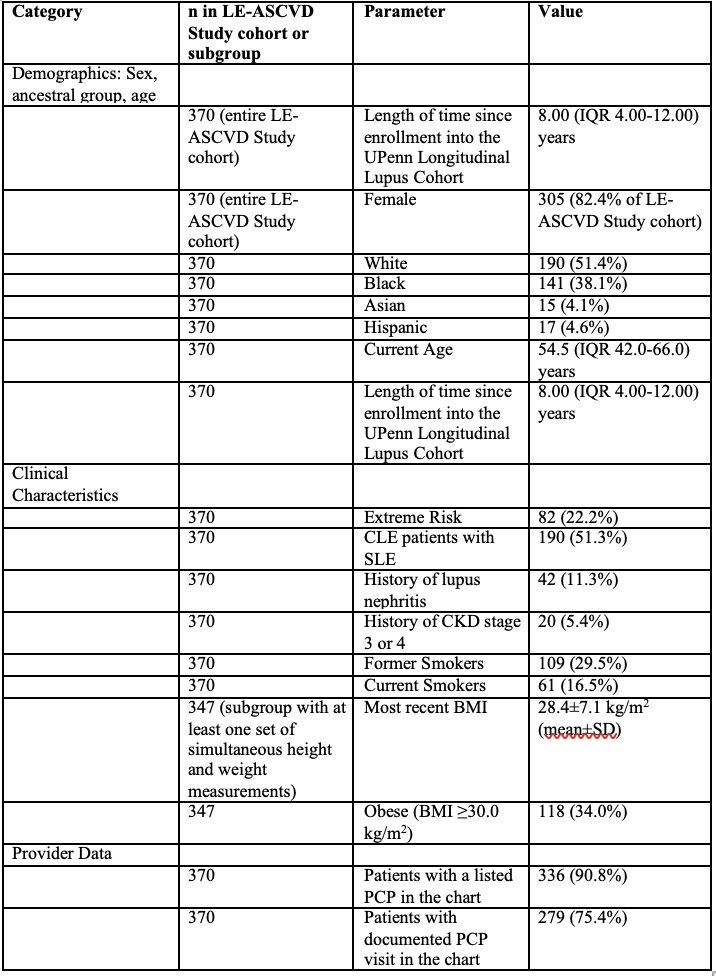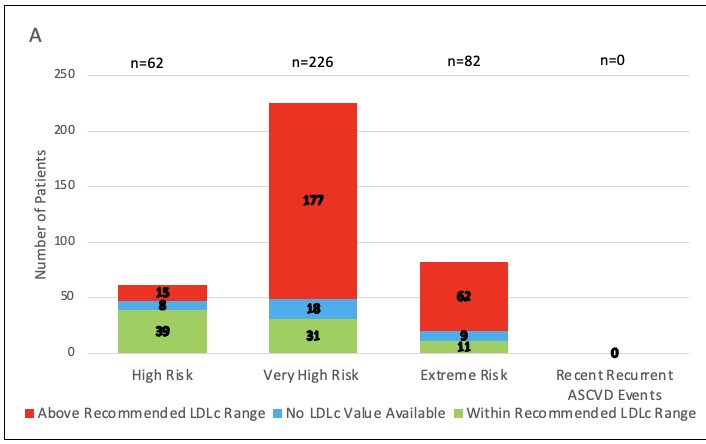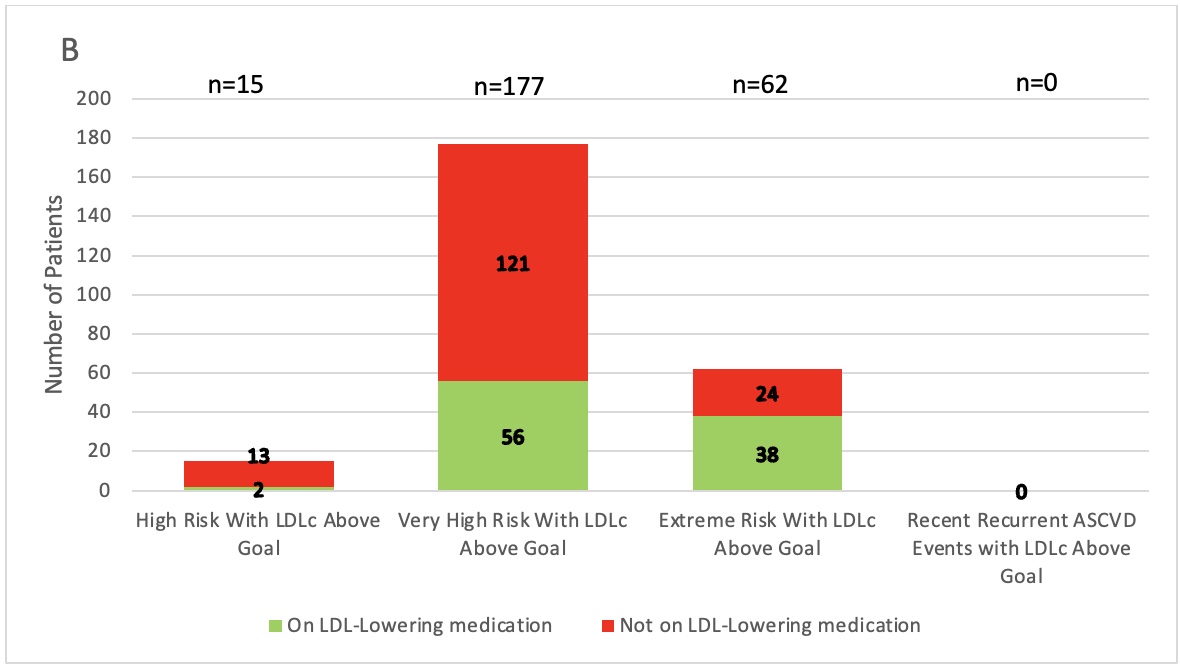Back
Poster Session C
Systemic lupus erythematosus (SLE)
Session: (1440–1485) SLE – Diagnosis, Manifestations, and Outcomes Poster II: Manifestations
1484: Management of the Heightened Risk for Clinical Events from Atherosclerotic Cardiovascular Disease (ASCVD) in an Established Cohort of Lupus Erythematosus Patients
Sunday, November 13, 2022
1:00 PM – 3:00 PM Eastern Time
Location: Virtual Poster Hall
- MZ
Megan Zhao, BA
Perelman School of Medicine
Broadview Hts, OH, United States
Abstract Poster Presenter(s)
Megan Zhao1, Kevin Williams2, Douglas Jacoby3, Rui Feng4 and Victoria Werth5, 1Perelman School of Medicine, Philadelphia, 2Temple University Hospital System, Philadelphia, 3University of Pennsylvania Health System, Philadelphia, 4University of Pennsylvania, Philadelphia, 5Philadelphia VAMC, Philadelphia, PA, USA and Department of Dermatology, Perelman School of Medicine at the University of Pennsylvania, Philadelphia
Background/Purpose: Lupus erythematosus (LE) patients are at heightened risk of clinical events, chiefly heart attacks and strokes, caused by ASCVD. To address this problem, we recently proposed new guidelines forcategorization of levels of risk for ASCVD events in LE patients, with corresponding recommendations for management of conventional risk factors, chiefly hypercholesterolemia, hypertension, smoking, and diabetes mellitus (Keyes E et al. 2021).
Methods: Here, we performed a single-center study of our established cohort of cutaneous LE patients without or with concurrent systemic LE (n=370). Our goal was to assess how current management compares with the newly proposed guidelines.
Results: Of our LE cohort, 336/370 (90.8%) had a designated primary care physician. By the newly proposed guidelines, the most recent plasma low-density lipoprotein cholesterol (LDLc) levels for 254/370 (68.6%) of the LE cohort were above goal. Of those 254 LE patients with above-goal LDLc, the following were not on any LDL-lowering medications: 13/15 (86.7%) classified at high ASCVD event risk, 121/177 (68.4%) at very high event risk, and 24/62 (38.7%) at extreme ASCVD event risk. The American College of Cardiology calculator for the 10-year risk of an ASCVD event could be used on 248/370 (67.0%) of the LE cohort. Of those 248 LE patients, the following were not on LDL-lowering medications: 109/129 (84.5%) who had a calculated 10-year event risk < 5%, 34/49 (69.4%) with 5-< 10% risk, 23/43 (53.5%) with 10-< 20% risk, and 11/27 (40.7%) with ≥20% risk. Of LE patients with clinically evident ASCVD, 36/82 (43.9%) were not on LDL-lowering medications.
Conclusion: We conclude that LE patients are undertreated for conventional ASCVD risk factors. Efforts to improve the problem are underway.
 Table 1. Demographics and other characteristics of the LE-ASCVD Study cohort.
Table 1. Demographics and other characteristics of the LE-ASCVD Study cohort.
Categorical parameter¬s are given as n (%). Continuous variables are given as mean±SD if normally distributed, or as median (interquartile range, IQR) if non-normally distributed.
 Assessment and management of plasma low-density lipoprotein cholesterol (LDLc) concentrations in the LE-ASCVD Study cohort. Panel A: ASCVD event risk categories by the newly proposed guidelines for lupus patients (Keyes et al. 2021) and achievement (green), or not (red), of the newly proposed LDLc goals for each risk category. Patients without an available LDLc value are indicated in blue.
Assessment and management of plasma low-density lipoprotein cholesterol (LDLc) concentrations in the LE-ASCVD Study cohort. Panel A: ASCVD event risk categories by the newly proposed guidelines for lupus patients (Keyes et al. 2021) and achievement (green), or not (red), of the newly proposed LDLc goals for each risk category. Patients without an available LDLc value are indicated in blue.
 Assessment and management of plasma low-density lipoprotein cholesterol (LDLc) concentrations in the LE-ASCVD Study cohort. Panel B: LDL-lowering medication use (green), or not (red), in patients assigned to each newly proposed risk category for lupus patients (Keyes et al. 2021) whose most recent plasma LDLc levels were above the newly proposed goals; these are the patients indicated in red in panel A.
Assessment and management of plasma low-density lipoprotein cholesterol (LDLc) concentrations in the LE-ASCVD Study cohort. Panel B: LDL-lowering medication use (green), or not (red), in patients assigned to each newly proposed risk category for lupus patients (Keyes et al. 2021) whose most recent plasma LDLc levels were above the newly proposed goals; these are the patients indicated in red in panel A.
Disclosures: M. Zhao, None; K. Williams, None; D. Jacoby, None; R. Feng, None; V. Werth, GlaxoSmithKline, CLASI.
Background/Purpose: Lupus erythematosus (LE) patients are at heightened risk of clinical events, chiefly heart attacks and strokes, caused by ASCVD. To address this problem, we recently proposed new guidelines forcategorization of levels of risk for ASCVD events in LE patients, with corresponding recommendations for management of conventional risk factors, chiefly hypercholesterolemia, hypertension, smoking, and diabetes mellitus (Keyes E et al. 2021).
Methods: Here, we performed a single-center study of our established cohort of cutaneous LE patients without or with concurrent systemic LE (n=370). Our goal was to assess how current management compares with the newly proposed guidelines.
Results: Of our LE cohort, 336/370 (90.8%) had a designated primary care physician. By the newly proposed guidelines, the most recent plasma low-density lipoprotein cholesterol (LDLc) levels for 254/370 (68.6%) of the LE cohort were above goal. Of those 254 LE patients with above-goal LDLc, the following were not on any LDL-lowering medications: 13/15 (86.7%) classified at high ASCVD event risk, 121/177 (68.4%) at very high event risk, and 24/62 (38.7%) at extreme ASCVD event risk. The American College of Cardiology calculator for the 10-year risk of an ASCVD event could be used on 248/370 (67.0%) of the LE cohort. Of those 248 LE patients, the following were not on LDL-lowering medications: 109/129 (84.5%) who had a calculated 10-year event risk < 5%, 34/49 (69.4%) with 5-< 10% risk, 23/43 (53.5%) with 10-< 20% risk, and 11/27 (40.7%) with ≥20% risk. Of LE patients with clinically evident ASCVD, 36/82 (43.9%) were not on LDL-lowering medications.
Conclusion: We conclude that LE patients are undertreated for conventional ASCVD risk factors. Efforts to improve the problem are underway.
 Table 1. Demographics and other characteristics of the LE-ASCVD Study cohort.
Table 1. Demographics and other characteristics of the LE-ASCVD Study cohort. Categorical parameter¬s are given as n (%). Continuous variables are given as mean±SD if normally distributed, or as median (interquartile range, IQR) if non-normally distributed.
 Assessment and management of plasma low-density lipoprotein cholesterol (LDLc) concentrations in the LE-ASCVD Study cohort. Panel A: ASCVD event risk categories by the newly proposed guidelines for lupus patients (Keyes et al. 2021) and achievement (green), or not (red), of the newly proposed LDLc goals for each risk category. Patients without an available LDLc value are indicated in blue.
Assessment and management of plasma low-density lipoprotein cholesterol (LDLc) concentrations in the LE-ASCVD Study cohort. Panel A: ASCVD event risk categories by the newly proposed guidelines for lupus patients (Keyes et al. 2021) and achievement (green), or not (red), of the newly proposed LDLc goals for each risk category. Patients without an available LDLc value are indicated in blue. Assessment and management of plasma low-density lipoprotein cholesterol (LDLc) concentrations in the LE-ASCVD Study cohort. Panel B: LDL-lowering medication use (green), or not (red), in patients assigned to each newly proposed risk category for lupus patients (Keyes et al. 2021) whose most recent plasma LDLc levels were above the newly proposed goals; these are the patients indicated in red in panel A.
Assessment and management of plasma low-density lipoprotein cholesterol (LDLc) concentrations in the LE-ASCVD Study cohort. Panel B: LDL-lowering medication use (green), or not (red), in patients assigned to each newly proposed risk category for lupus patients (Keyes et al. 2021) whose most recent plasma LDLc levels were above the newly proposed goals; these are the patients indicated in red in panel A.Disclosures: M. Zhao, None; K. Williams, None; D. Jacoby, None; R. Feng, None; V. Werth, GlaxoSmithKline, CLASI.

